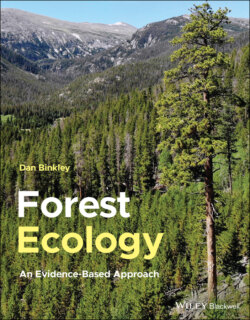Читать книгу Forest Ecology - Dan Binkley - Страница 30
CHAPTER 2 Forest Environments
ОглавлениеForests change across landscapes, and some of the changes result from gradients in environmental factors such as temperature and available water. Patterns of forest change across landscapes relate broadly to patterns of environmental factors, such as typical changes in the dominant species as elevation increases in mountains (Figure 2.1). Some broad generalizations may explain general patterns: temperatures are lower at higher elevations, and precipitation is generally (but not always) higher. The underlying details that influence both the broad patterns and specific cases are a bit complex and highly interacting. This chapter develops a foundation for understanding the fundamental physics that influence tree occurrence and growth. Later chapters expand to examine how ecological interactions (including plants, animals and microbes) and environmental factors combine to shape forests.
All the chemical and biological processes within a forest are driven by physical processes: environmental temperatures, water regimes, and solar radiation. In turn, the chemical and biological processing of solar energy shape the microenvironmental conditions found in forests. Interception of sunlight by trees not only drives photosynthesis, it leads to evaporation of water from leaves, cooling the leaf and increasing the humidity of the air. Evaporation of water from leaves (transpiration) physically lifts masses of water and nutrients from the soil up to the canopy, and cools leaves heated by sunshine. Energy “fixed” through photosynthesis cascades down a series of chemical reactions, driving the forest's chemistry and biology until all the energy has been dissipated as heat. All the interesting biology and ecology that occur in forests take place within this physical system.
FIGURE 2.1 The vegetation in the Front Range of the Rocky Mountains in northern Colorado, USA grades from primarily grass/shrub domination at low, dry elevations, through open pine‐dominated woodlands, to aspens mixed with a variety of conifers, to forests of spruce and fir and then to tundra (alpine) at the highest elevations
(Source: based on a diagram from Laurie Huckaby).
The patterns depend on direct effects of environmental factors on tree physiology, and also environmental influences on fires, insects, and other forest‐shaping agents.
